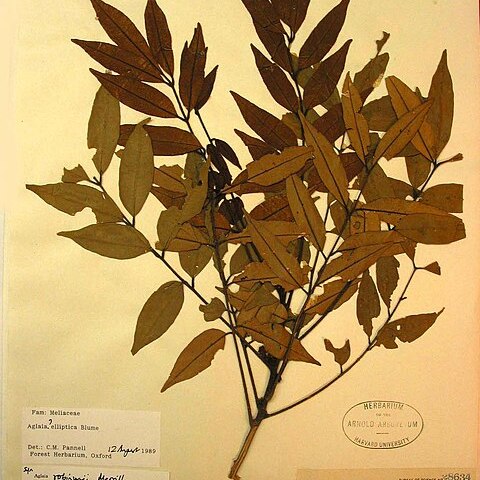Tree 2–20(–40) m, with an irregularly rounded crown. Bole up to 15 m, up to 50 cm in diam., sometimes fluted throughout, with L-shaped buttresses upwards up to 150 cm, outwards up to 100 cm and up to 45 cm thick. Bark dark reddish-brown or greenish-brown with shallow pits, inner bark magenta; sapwood pale yellow pinkish-red or dark reddish-brown; latex white. Branches patent or ascending. Twigs densely covered with usually reddish-brown, pale orange brown or yellowish-brown stellate hairs or scales, sometimes with pale brown or reddish-brown peltate scales which have a fimbriate margin, Leaves imparipinnate, 15–65 cm long, 12–60 cm wide; petiole 3–10 cm, petiole, raclais and petiolules densely covered with stellate hairs or scales like those on the twigs. Leaflets (5–)7–11(–16 in rheophytic form in Borneo), 5–34.5 by 1–11 cm, young leaves yellowish-green turning darker green when mature, usually elliptical (narrowly elliptical in the rheophytic form) or oblanceolate-oblong, rarely oblong, the apex acuminate or acuminate-caudate, cuneate or rounded at the sometimes asymmetrical base, the young leaves densely covered with hairs and stellate scales like those on the twigs on both surfaces, when mature the upper and lower surfaces sometimes pitted, with hairs or stellate scales like those on the twigs numerous on to densely covering the midrib and sometimes the lateral veins below, few on the rest ofthat surface; veins 6–19 on each side of the midrib; petiolules 4–20(–24) mm. Male inflorescence 23–50 cm long, 14– 60 cm wide; peduncle 1–10 cm, peduncle, rachis and branches with indumentum like that on the twigs. Flowers up to 6,000, 1.2–1.5 mm long, 1–1.6 mm wide; pedicels 0.5–2 mm, with indumentum like the twigs. Calyx densely covered with brown stellate scales on the outside. Petals 5. Staminal tube 0.5–0.75 mm long, 1 mm wide, shallow-ly cup-shaped, yellow, thickened inside below the insertion of the anthers, the apical margin shallowly or deeply 5-lobed (in the rheophytic form, the staminal tube is divided almost to the base into 5 lobes); anthers c. 0.4 mm long and 0.3 mm wide, yellow when immature, brown at anthesis, turning black later, ovoid, inserted just below the aperture and pointing towards the centre of the flower. Female inflorescence 13–37 cm long and 5–14 cm wide, with fewer branches and fewer flowers than in the male; peduncle 2–7 cm. Flowers 1.8–2.2 mm long, 2–2.5 mm wide, otherwise similar. Infructescence 5.5–30 cm long and 5–15 cm wide with few to 100 or more fruits, when numerous the fruits packed tightly together; peduncle up to 10 cm, peduncle, rachis, branches and fruitstalks with numerous stellate hairs and scales. Fruits 1.5–3.5(–5) cm long, 1.5–3 (–5) cm wide, bright pale green when young, orange when mature, obovoid or ellip-soid, indéhiscent, with few to densely covered with reddish-brown stellate scales; peri-carp 3–10 mm thick, inner surface shiny, orange, white latex present until fruit ripens, opening under pressure loculicidally along a longitudinal ridge encircling the fruit. Loc-ules 2; septum persistent. Seeds 1 or 2, 2.2–2.8 cm long, 1–1.4 cm across, ovoid, the inner surface flattened; aril 2–3 mm thick, sometimes not quite complete on the antiraphe side, pinkish-orange, translucent, sweet or acidic tasting; with two layers beneath the aril, the outer hard, chestnut brown, the inner thin and membraneous, with the main vas-cular bundle running through the raphe and antiraphe, divaricately branching from the raphe over the sides of the seed. 2n = 68 [ Pannell Kew Bull., Add. Ser. 16 1992 21 ].
More
A large tree. It grows up to 25 m tall. The trunk is 50 cm across. It has buttresses. The leaves are alternate and compound. They have 5-7 pairs of leaflets and one at the end. They are smooth and pointed at both ends. They can have rusty hairs. The flowers are small, yellow and borne in large compound flower clusters. The fruit is an almost round berry. It is red. It has a hard outer covering. It is 2-2.5 cm across. It has one seed. The layer around the seed or aril is edible.


